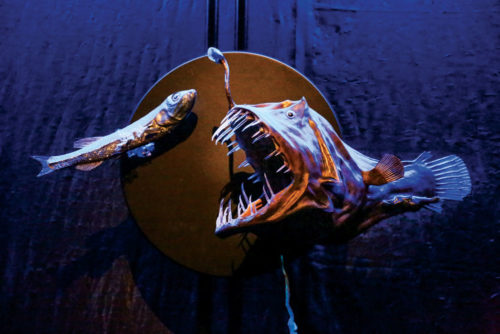
Frank Krell, DMNS entomologist and curator, stands underneath a giant model of a firefly. “The science behind bioluminescence does not explain its enchantment away, rather it makes these phenomena even more fascinating.”
All that glitters isn’t gold—it might be a bug or a fish. The Denver Museum of Nature and Science (DMNS) celebrates all living things that blink, glow, flash and flicker at its Creatures of Light exhibition, through June 10. From microscopic bacteria to creepy predators in the ocean’s depths, the presentation explores the world of bioluminescence and biofluorescence: organisms that generate their own light or reflect light.
To view the full article, click here: Creatures of Light
“Many of us have seen lawns full of fireflies at night, though perhaps not here in Colorado,” said Frank Krell, DMNS entomologist and curatorial advisor for the exhibition. “Colorado does have fireflies—which are actually beetles—but not many of the kind that light up. Fireflies are more numerous in humid areas because they eat snails and slugs. We’re too dry in Colorado, although you might see them in irrigated areas or near creeks on warm summer nights.”

When this jellyfish is poked, spots on its rim light up like an emerald necklace. Its glow is both bioluminescent and fluorescent. A chemical reaction produces blue bioluminescent light, and a fluorescent molecule turns the blue light to green.
How do fireflies and other living things produce light? “It’s a chemical process,” Krell said. “In the firefly’s abdomen, specific enzymes work in the presence of oxygen to produce light.”
A wide variety of both terrestrial and marine creatures can produce or reflect light. Organisms use a variety of body parts to emit light in different colors and for different purposes, but the mechanism is much the same, Krell said.
In Creatures of Light, visitors move through a series of re-created environments, from the familiar to the extreme, to show light-producing organisms as different as mushrooms and scorpions. “This show will be a family favorite because it engages kids in so many activities,” said Maura O’Neal, communications and media relations manager at the museum. “Even infants will like it because of the lightshow.”
The exhibit immerses visitors into semi-darkness to explore the variety of ways living creatures use bioluminescence and biofluorescence. “The light may be used to attract a mate, to lure prey, or to defend against predators. Some creatures use it to be invisible to predators,” Krell said.
He said some species of fireflies communicate with specific flash patterns to signal their availability and attract potential mates. “Predators can imitate the pattern to attract prey.”
Millipedes in the Motyxia genus glow with an eerie green color. “The millipede produces cyanide. It lives at night and it glows to signal to predators that it is not safe to eat,” said Krell.
Most bioluminescent organisms live in the world’s oceans, from the shallows to the deep sea floor. “Ocean creatures produce light to communicate. Blue light goes deep, while red light is filtered out,” said Krell.

The anglerfish attracts prey with its built-in lure that pulses with light. If another fish gets too close, it’s a meal.
Brittle stars, related to starfish, light up in blue or green when grabbed by a predator. “If the predator swallows the brittle star, it will glow, making it visible to larger predators,” Krell said. “So the predator spits it out.”
Interactive sections include a re-created Puerto Rican lagoon full of plankton that light up as visitors walk across it. Kids can peer into the darkness of a New Zealand cave to see glowworms, like long strands of stars. “Glowworms produce blue light to attract insects into the cave,” Krell said.
Live organisms in the exhibition—including a scorpion, bacteria and fungi—demonstrate biofluorescence. Biofluorescent organisms absorb light and transform it into a different color. In the ocean, blue light penetrates through the water, where some organisms absorb it and emit light at a lower energy, such as green or red. A “Does it Glow” activity lets visitors test everyday objects for fluorescence.
A tank of live GloFish demonstrates how fluorescence may help detect pollution and be used for medical research. “With cellular tagging, we use fluorescent proteins to see what living cells are doing. It helps us understand more about Alzheimer’s and cancer,” said Krell.
For more information, see dmns.org/creatures-of-light.



0 Comments